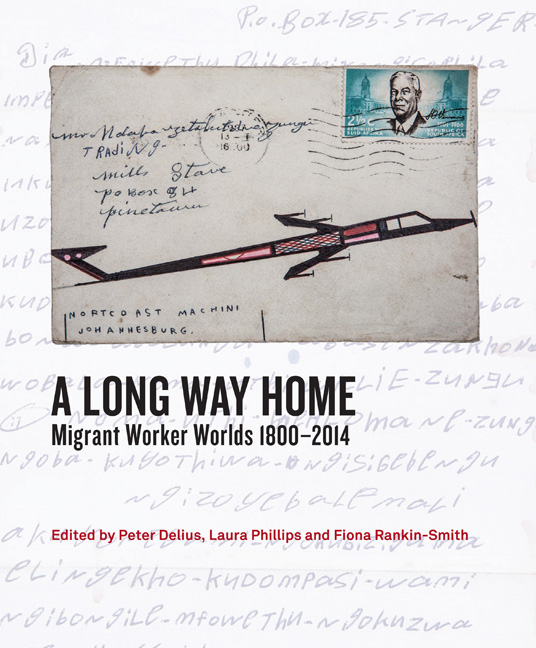Book contents
- Frontmatter
- Contents
- Acknowledgements
- Introduction: Highlighting Migrant Humanity
- Chapter 1 Ngezinyawo - Migrant Journeys
- Chapter 2 Slavery, Indenture and Migrant Labour: Maritime Immigration from Mozambique to the Cape, c.1780–1880
- Chapter 3 Walking 2 000 Kilometres to Work and Back: The Wandering Bassuto by Carl Richter
- Chapter 4 A Century of Migrancy from Mpondoland
- Chapter 5 The Migrant Kings of Zululand
- Chapter 6 The Art of Those Left Behind: Women, Beadwork and Bodies
- Chapter 7 The Illusion of Safety: Migrant Labour and Occupational Disease on South Africa's Gold Mines
- Chapter 8 ‘The Chinese Experiment’: Images from the Expansion of South Africas ‘Labour Empire’
- Chapter 9 ‘Stray Boys’: The Kruger National Park and Migrant Labour
- Chapter 10 Surviving Drought: Migrancy and the Homestead Economy
- Chapter 11 Migrants from Zebediela and Shifting Identities on the Rand, 1930s–1970s
- Chapter 12 Verwoerd's Oxen: Performing Labour Migrancy in Southern Africa
- Chapter 13 ‘Give My Regards to Everyone at Home Including Those I No Longer Remember’: The Journey of Tito Zungu's Envelopes
- Chapter 14 Sophie and the City: Womanhood, Labour and Migrancy
- Chapter 15 Bungityala
- Chapter 16 Migrants: Vanguard of the Worker's Struggles?
- Chapter 17 Debt or Savings? Of Migrants, Mines and Money
- Chapter 18 Post-Apartheid Migrancy and the Life of a Pondo Mineworker
- Notes on Contributors
- List of Figures and Tables
- Index
Chapter 11 - Migrants from Zebediela and Shifting Identities on the Rand, 1930s–1970s
Published online by Cambridge University Press: 04 July 2018
- Frontmatter
- Contents
- Acknowledgements
- Introduction: Highlighting Migrant Humanity
- Chapter 1 Ngezinyawo - Migrant Journeys
- Chapter 2 Slavery, Indenture and Migrant Labour: Maritime Immigration from Mozambique to the Cape, c.1780–1880
- Chapter 3 Walking 2 000 Kilometres to Work and Back: The Wandering Bassuto by Carl Richter
- Chapter 4 A Century of Migrancy from Mpondoland
- Chapter 5 The Migrant Kings of Zululand
- Chapter 6 The Art of Those Left Behind: Women, Beadwork and Bodies
- Chapter 7 The Illusion of Safety: Migrant Labour and Occupational Disease on South Africa's Gold Mines
- Chapter 8 ‘The Chinese Experiment’: Images from the Expansion of South Africas ‘Labour Empire’
- Chapter 9 ‘Stray Boys’: The Kruger National Park and Migrant Labour
- Chapter 10 Surviving Drought: Migrancy and the Homestead Economy
- Chapter 11 Migrants from Zebediela and Shifting Identities on the Rand, 1930s–1970s
- Chapter 12 Verwoerd's Oxen: Performing Labour Migrancy in Southern Africa
- Chapter 13 ‘Give My Regards to Everyone at Home Including Those I No Longer Remember’: The Journey of Tito Zungu's Envelopes
- Chapter 14 Sophie and the City: Womanhood, Labour and Migrancy
- Chapter 15 Bungityala
- Chapter 16 Migrants: Vanguard of the Worker's Struggles?
- Chapter 17 Debt or Savings? Of Migrants, Mines and Money
- Chapter 18 Post-Apartheid Migrancy and the Life of a Pondo Mineworker
- Notes on Contributors
- List of Figures and Tables
- Index
Summary
Zebediela is an area in the Limpopo province, situated approximately 40 kilometres south-east of Mokopane (previously known as Potgietersrus). It is home to ethnically mixed communities consisting primarily of Northern Ndebele and Northern Sotho/Pedi people under the Kekana-Ndebele chieftaincy. The chiefdom of Zebediela existed as an autonomous polity until 1885 when it was beaconed off and demarcated as a ‘native location’ by the Zuid-Afrikaansche Republiek (ZAR). In the years before it was reduced to a native location, however, groups of male migrants from this chiefdom had been travelling hundreds of kilometres on foot to white settlements further south, where they engaged in wage labour. With their earnings, they paid colonial taxes and bought guns, which were required to safeguard the independence of their chiefdom. In 1879, the Native Commissioner for the district described Zebediela as ‘rich and well-to-do’ and lamented the fact that none of the young men from this chiefdom would work elsewhere, other than at the diamond fields (Kimberley) where they earned higher wages. By the early twentieth century, however, the wages had been depressed and the flood of young men to the diamond fields turned into a trickle.
In 1917, entrepreneur and financier IW Schlesinger purchased a massive tract of land on the southern side of the location and immediately commenced with the establishment of the Zebediela Citrus Estates. Consequently, many people were dispossessed of their land and turned into wage labourers. The largest undertaking of its kind in the southern hemisphere, the development of the Zebediela Citrus Estate (starting in 1918) and the damming of the Gompies River (Nkumpi), which served as a major source of water for the communities and their livestock downstream, caused massive displacement and disruption of people's livelihoods in the location. Within a decade of the citrus estate's establishment, the supply of labour, according to the estate management's reports, had become so plentiful that many from the Zebediela location itself accepted wages as low as 25 shillings per month, excluding provisions. However, as the South African economy moved from a period of depression to one of rapid growth in the 1930s, the demand and competition for labour increased accordingly and migrants from the location once again pursued the more well-paid labour markets of the Witwatersrand (also referred to as the Rand or Reef).
- Type
- Chapter
- Information
- A Long Way HomeMigrant Worker Worlds 1800–2014, pp. 155 - 168Publisher: Wits University PressPrint publication year: 2014

